UN climate report: country impacts

People walk through a part of lower Manhattan that increasingly experiences flooding on August 09, 2021 in New York City. AFP
PARIS — From cities and small islands threatened by rising seas, to regions facing extreme drought and deadly heatwaves, climate change threatens every part of the planet, the UN warned on Monday.
Here are 10 key climate change threats and how they will hit various countries if emissions are not cut fast, according to the Intergovernmental Panel on Climate Change’s new report.
Heat: Sydney at 50C
Parts of the world will get too hot and humid for humans to live in this century if carbon emissions keep rising. Elsewhere, the heat will make it deadly to work outside for part of the year.
In Africa, heat and humidity would kill 50-180 more people per 100,000 each year if the globe warms by 2.5C. Under current targets, global temperatures are set to rise 2.7C, the UN estimates.
If global temperatures rise 2C, Sydney and Melbourne could reach 50C. Farm workers in the US could suffer dangerous heat and humidity if emissions are high.
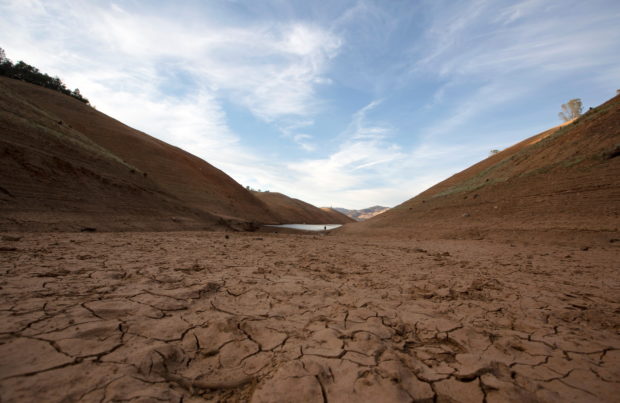
Dry land is visible, at a section that is normally under water, on the banks of Lake Oroville, which is the second largest reservoir in California and according to daily reports of the state’s Department of Water Resources is near 35% capacity near Oroville, California, U.S., June 16, 2021. . REUTERS FILE PHOTO
Drought: US crops hit
Hotter weather will lower rivers and reservoirs and dry up crops if emissions are not cut. Drought is already slowing growth in crop yields.
In the United States, crop losses such as those in the 2012 Midwest and Great Plains drought have been partly attributed to climate change.
In Europe, crop losses due to drought and heat have tripled over the past 50 years and will grow with continued warming.
Floods: Rising in Europe
Even with more drought in some places, others will suffer more flash floods and landslides as climate change messes up rain patterns.
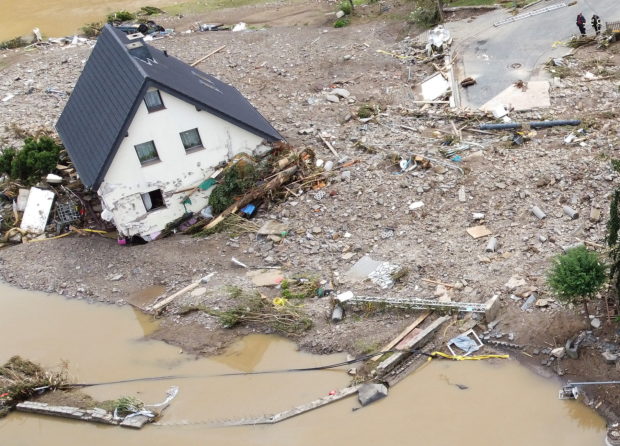
A general view of flood-affected area following heavy rainfalls in Schuld, Germany, on July 15, 2021. Picture taken with a drone. REUTERS
In Europe, the last three decades saw the most floods in 500 years. Floods like the ones that struck Germany, Belgium and the Netherlands in 2021 will get more frequent.
In Canada, winter rainfall is expected to increase, driving floods such as those that hit its Pacific coast in November 2021. Japan is already seeing a significant increase in the number of heavy rain events every year.
Wildfires: Growing in Canada
Wildfires such as those that ravaged Australia, Canada and the United States in recent years are forecast to get worse with climate change.
Fires in Australia are getting fiercer and more frequent, with an increase of up to 70 percent more fire days expected by 2050 in some regions if emissions continue to rise.
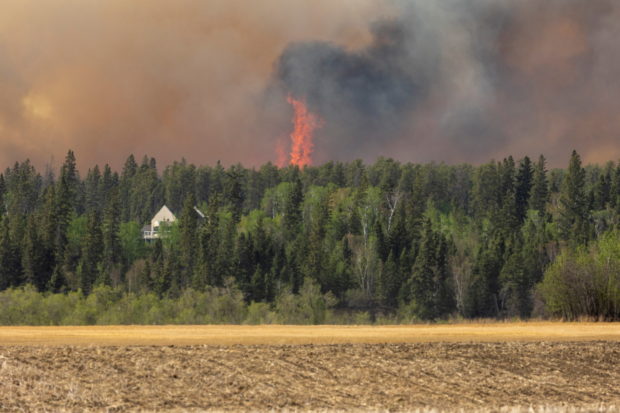
Wildfires burn near a house as the city of Prince Albert declared a state of emergency over a fast-moving wildfire, prompting some residents to evacuate, in Prince Albert, Saskatchewan, Canada May 18, 2021. REUTERSFILE PHOTO
In Canada, climate change climate change has led to warmer and drier conditions. That has seen the area burned increase in the last several decades and is projected to worsen, with longer fire seasons and higher temperatures, like those seen in the 2021 heatwave. Annual fire costs there could more than double to $ one billion by the end of the century, even if emissions drop fast.
Food: At risk in Africa
Worsening weather extremes threaten world food supplies, disrupting grain, meat, dairy and fish. Food production is already lower than it would have been without climate change — productivity has slowed by 21 percent.
The amount of fish that can be sustainably harvested from certain marine populations decreased by 4.1 percent globally from 1930 to 2010.
The number of people at risk of hunger by 2050 will increase by eight to 80 million, depending on the degree of warming, most of them in Sub-Saharan Africa, South Asia and Central America.
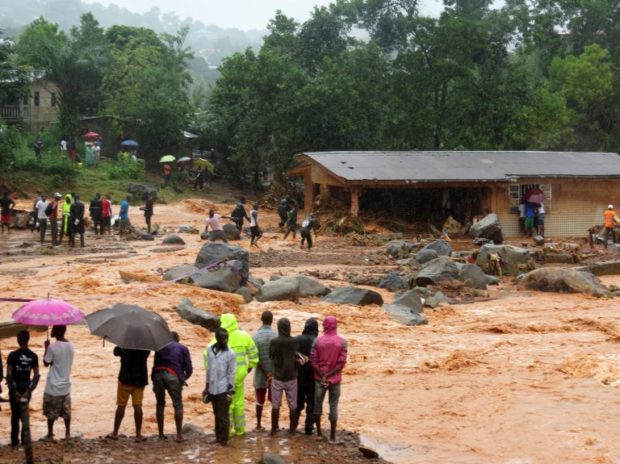
Bystanders look on as floodwaters rage past a damaged building in an area of Freetown on August 14, 2017, after landslides struck the capital of the west African state of Sierra Leone. AFP
Heat and extreme rain harm soil; too much CO2 reduces nutrients and vitamins in crops. The risks of crop failure, food shortages and price rises will grow if emissions are not cut fast.
Species: Extinction in Costa Rica
Climate change is threatening animals and plants and has already driven some to extinction.
Two species are documented to have gone extinct due to climate change: the Golden toad of Costa Rica, stricken by drought, and the Bramble Cay Melomys mouse in Australia, hit by rising seas and storms.
In South Africa, 14 species of birds and fruit bats died en masse in 2020 due to extreme heat. The African penguin’s population has fallen 96 percent since 1900, mostly in the past two decades.
Protection measures will not be enough without faster emission cuts, the report warns. Coral reefs will virtually disappear with 2C warming.
Forests: Vanishing in Brazil
Heat, drought and wildfires are killing trees and breaking their ecosystems, turning forests to dry grassland – and leaving fewer trees to help absorb the CO2.
In Brazil half the Amazon rainforest could turn to grassland if emissions continue to rise, the report warns. Lower emissions could limit the loss to five percent.
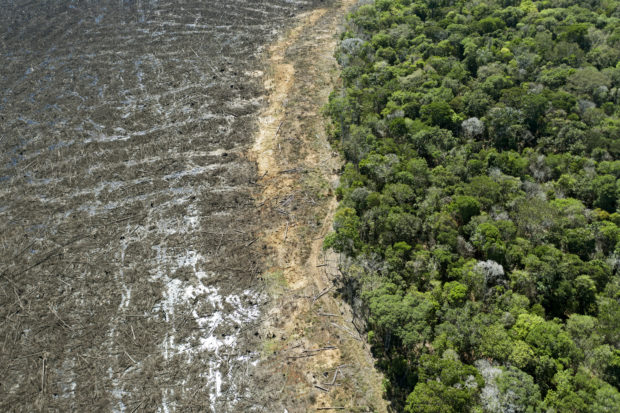
In this file photo taken on August 07, 2020, aerial picture of a deforested area close to Sinop, Mato Grosso State, Brazil. AFP
This would have devastating consequences for biodiversity and indigenous peoples, while releasing carbon stored in trees and further driving global warming.
Studies cited in the report also show the threat from high emissions to forests in Europe, the United States, Canada and Australia.
Sea rise: Cities in China
Millions of people could be displaced this century by rising seas that will cover the land or ruin it for farming. Some small islands are likely to become uninhabitable without quick emissions cuts.
Globally, sea levels will likely rise between 44 and 76 centimetres this century if governments meet their current pledges, said the IPCC’s 2021 report. Faster cuts could limit this to 28-55cm.
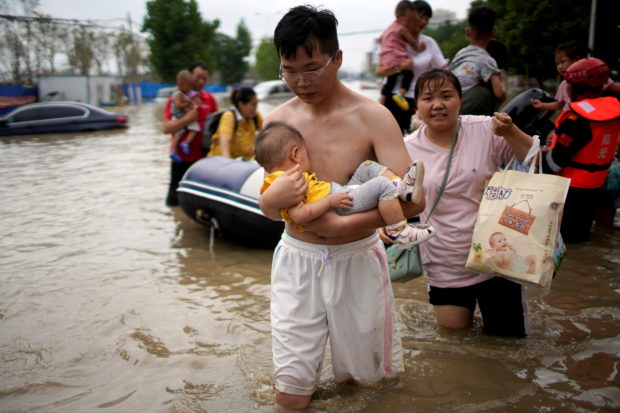
A man holding a baby wades through a flooded road following heavy rainfall in Zhengzhou, Henan province, China July 22, 2021. REUTERS FILE PHOTO
The countries most vulnerable include Bangladesh, India, Indonesia and Japan. Guangzhou in southern China ranks as the city most economically vulnerable to sea-level rise, the new report says: it could lose hundreds of billions of dollars a year by 2050 if emissions are high.
Ice: Melting in Scandinavia
Rising heat is melting ice and snow, disrupting ecosystems and infrastructure. Low-altitude ski resorts will rely on expensive snowmaking to survive.
Mountain glaciers in Scandinavia, central Europe and the Caucasus are projected to lose 60-80 percent of their mass by the end of the century. Lake, river and sea ice have decreased. Changing ice has disrupted reindeer herding by the Sami people in Lapland.
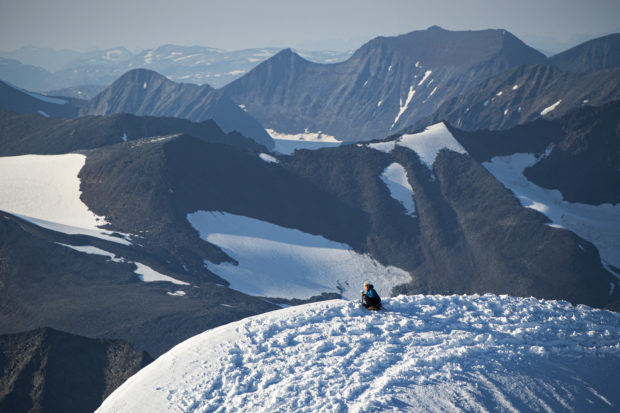
A photo taken from a helicopter shows Researcher Ninis Rosqvist at the peak of the southern summit of Kebnekaise in northern Sweden, as she uses equipment to take GPS measurements on the mountain’s height on August 26, 2021. AFP
In Canada, permafrost thawing has led to disruptions in airport operations, railways, water and sewage services and schools. Similar damage is also documented in Russia.
Economy: Threatened worldwide
Climate change is curbing growth and incomes and threatens trillions of dollars’ worth of damage.
Estimates cited in the report say high warming of 4C could drag down global GDP between 10 and 23 percent this century, compared to a world without warming. With no action, climate change could push between 35 and 132 million more people into extreme poverty by 2030.
GDP per capita was 13.6 percent lower for African countries in 2010 than it would have been without global warming since 1991. Sub-Saharan Africa could lose a further 12 percent of GDP by 2050 and 80 percent by 2100 with high emissions.
RELATED STORIES
Climate change and the common Filipino
The economic imperative to act on climate change
Nations to review harrowing catalogue of climate impacts
UN science report to sound deafening alarm on climate